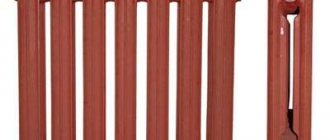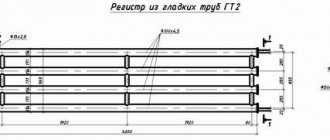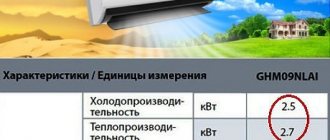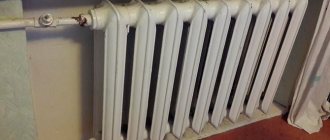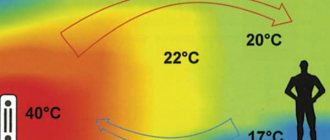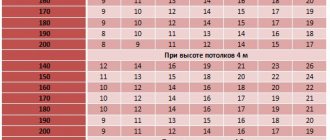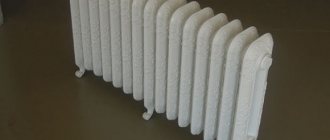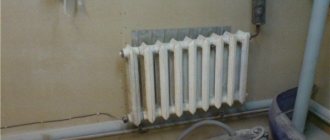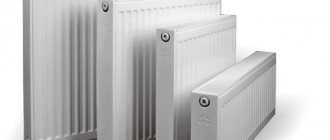A well-designed heating system will provide housing with the required temperature and all rooms will be comfortable in any weather. But in order to transfer heat to the air space of residential premises, you need to know the required number of batteries, right?
Calculation of heating radiators, based on calculations of the thermal power required from the installed heating devices, will help to find out this.
Have you never done such calculations and are afraid of making mistakes? We will help you understand the formulas - the article discusses a detailed calculation algorithm and analyzes the values of individual coefficients used in the calculation process.
To make it easier for you to understand the intricacies of the calculation, we have selected thematic photographic materials and useful videos that explain the principle of calculating the power of heating devices.
Simplified calculation of heat loss compensation
Any calculations are based on certain principles. The calculations of the required thermal power of batteries are based on the understanding that well-functioning heating devices must fully compensate for the heat losses that occur during their operation due to the characteristics of the heated premises.
For living rooms located in a well-insulated house, located, in turn, in a temperate climate zone, in some cases a simplified calculation of compensation for heat leakage is suitable.
For such premises, calculations are based on a standard power of 41 W required to heat 1 cubic meter. living space.
In order for the thermal energy emitted by heating devices to be directed specifically at heating the premises, it is necessary to insulate walls, attics, windows and floors
The formula for determining the thermal power of radiators necessary to maintain optimal living conditions in a room is as follows:
Q = 41 x V,
where V is the volume of the heated room in cubic meters.
The resulting four-digit result can be expressed in kilowatts, reducing it at the rate of 1 kW = 1000 W.
Calculation of Kermi radiators
Before calculating the thermal power, you should decide on the manufacturer of the device that will be installed in the room. It is obvious that the leaders of this industry deservedly have the best recommendations. Let's turn to the table of the famous German manufacturer Kermi, on the basis of which we will carry out the necessary calculations.
For example, let's take one of the newest models - ThermX2Plan. From the table you can see that the power parameters are specified for each Kermi model, so you just need to find the desired device from the list. In the heating area, it is not required that the indicators completely coincide, so it is better to take a value that is slightly larger than calculated. This way you will have the necessary reserves for periods of sudden cold snap.
All suitable indicators are marked in the table with red squares. Let’s say that for us the most optimal radiator height is 505 mm (listed at the top of the table). The most attractive option is type 33 devices with a length of 1005 mm. If shorter devices are required, you should opt for models with a height of 605 mm.
Practical example of calculating thermal power
Initial data:
- A corner room without a balcony on the second floor of a two-story cinder block plastered house in a windless region of Western Siberia.
- Room length 5.30 m X width 4.30 m = area 22.79 sq.m.
- Window width 1.30 m X height 1.70 m = area 2.21 sq.m.
- Room height = 2.95 m.
Calculation sequence:
| Room area in sq.m.: | S = 22.79 |
| Window orientation – south: | R = 1.0 |
| Number of external walls – two: | K = 1.2 |
| Insulation of external walls is standard: | U=1.0 |
| Minimum temperature – up to -35°C: | T=1.3 |
| Room height – up to 3 m: | H=1.05 |
| The upstairs room is an uninsulated attic: | W=1.0 |
| Frames – single-chamber double-glazed windows: | G=1.0 |
| The ratio of window and room areas is up to 0.1: | X = 0.8 |
| Radiator position – under the window sill: | Y=1.0 |
| Radiator connection – diagonally: | Z=1.0 |
| Total (remember to multiply by 100): | Q = 2,986 Watts |
Below is a description of calculating the number of radiator sections and the required number of batteries. It is based on the obtained results of thermal power, taking into account the dimensions of the proposed installation locations of heating devices.
Regardless of the results, it is recommended to equip not only window sill niches with radiators in corner rooms. Batteries should be installed near “blind” external walls or near corners that are subject to the greatest freezing under the influence of street cold.
Specific thermal power of battery sections
Even before performing a general calculation of the required heat transfer of heating devices, it is necessary to decide what material the collapsible batteries will be installed in the premises from.
The choice should be based on the characteristics of the heating system (internal pressure, coolant temperature). At the same time, do not forget about the greatly varying costs of purchased products.
How to correctly calculate the required number of different batteries for heating will be discussed further.
At a coolant temperature of 70 °C, standard 500 mm sections of radiators made of dissimilar materials have unequal specific thermal power “q”.
- Cast iron – q = 160 Watt (power density of one cast iron section). Radiators made of this metal are suitable for any heating system.
- Steel – q = 85 Watt . Steel tubular radiators can operate in the harshest operating conditions. Their sections are beautiful in their metallic shine, but have the lowest heat transfer.
- Aluminum – q = 200 Watt . Lightweight, aesthetic aluminum radiators should be installed only in autonomous heating systems in which the pressure is less than 7 atmospheres. But their sections have no equal in terms of heat transfer.
- Bimetal – q = 180 Watt . The insides of bimetallic radiators are made of steel, and the heat-dissipating surface is made of aluminum. These batteries will withstand all pressure and temperature conditions. The specific thermal power of bimetal sections is also high.
The given values of q are rather arbitrary and are used for preliminary calculations. More accurate figures are contained in the passports of the purchased heating devices.
Image gallery
Photo from
Advantages of the sectional assembly principle
Basic rules for assembling heating devices
Sections of an obsolete cast iron battery
Powder coated colored sections
Radiator heat transfer: what does this indicator mean?
The term heat transfer means the amount of heat that a heating battery transfers to a room over a certain period of time.
There are several synonyms for this indicator: heat flow; thermal power, device power. The heat output of heating radiators is measured in Watts (W). Sometimes in the technical literature you can find a definition of this indicator in calories per hour, with 1 W = 859.8 cal/h. Heat transfer from radiators occurs through three processes:
- heat transfer;
- convection;
- radiation (radiation).
Each heating device uses all three heat transfer options, but their ratio differs for different models. Previously, it was customary to call radiators devices in which at least 25% of the thermal energy is released as a result of direct radiation, but now the meaning of this term has expanded significantly. Nowadays, convector-type devices are often called this.
Calculation of the number of radiator sections
Collapsible radiators made of any material are good because to achieve their calculated thermal power, you can add or subtract individual sections.
To determine the required number “N” of battery sections from the selected material, the formula is followed:
N=Q/q,
Where:
- Q = previously calculated required thermal output of devices for heating the room,
- q = specific thermal power of a separate section of batteries proposed for installation.
Having calculated the total required number of radiator sections in the room, you need to understand how many batteries need to be installed. This calculation is based on a comparison of the dimensions of the proposed installation locations of heating devices and the dimensions of the batteries, taking into account the connections.
The battery elements are connected by nipples with multi-directional external threads using a radiator wrench, and at the same time gaskets are installed at the joints
For preliminary calculations, you can arm yourself with data on the width of sections of different radiators:
- cast iron = 93 mm,
- aluminum = 80 mm,
- bimetallic = 82 mm.
When making collapsible radiators from steel pipes, manufacturers do not adhere to certain standards. If you want to install such batteries, you should approach the issue individually.
You can also use our free online calculator to calculate the number of sections:
Selecting a radiator based on calculation
Steel radiators
Let's leave the comparison of heating radiators out of the picture and note only the nuances that you need to have an idea about when choosing a radiator for your heating system.
In the case of calculating the power of steel heating radiators, everything is simple. There is the necessary power for an already known room - 2025 watts. We look at the table and look for steel batteries that produce the required number of watts. Such tables are easy to find on the websites of manufacturers and sellers of similar products. Pay attention to the temperature conditions at which the heating system will be operated. It is optimal to use the battery in 70/50 C mode.
The table indicates the type of radiator. Let's take type 22 as one of the most popular and quite worthy in terms of its consumer qualities. A 600x1400 radiator is perfect. The power of the heating radiator will be 2015 W. It's better to take a little extra.
Aluminum and bimetallic radiators
Aluminum and bimetallic radiators are often sold in sections.
Capacity in tables and catalogs is indicated for one section. It is necessary to divide the power required to heat a given room by the power of one section of such a radiator, for example: 2025/150 = 14 (rounded to whole numbers)
We have obtained the required number of sections for a room with a volume of 45 cubic meters.
Increased heat transfer efficiency
When the radiator heats the internal air of the room, intense heating of the external wall in the area behind the radiator also occurs. This leads to additional unjustified heat losses.
To increase the efficiency of heat transfer from the radiator, it is proposed to fence off the heating device from the outer wall with a heat-reflecting screen.
The market offers many modern insulating materials with a heat-reflecting foil surface. The foil protects the warm air heated by the battery from contact with the cold wall and directs it inside the room.
For proper operation, the boundaries of the installed reflector must exceed the dimensions of the radiator and protrude 2-3 cm on each side. The gap between the heating device and the thermal protection surface should be left 3-5 cm.
To make a heat-reflecting screen, we can recommend isospan, penofol, alufom. A rectangle of the required dimensions is cut out of the purchased roll and fixed on the wall at the location where the radiator is installed.
It is best to fix the screen that reflects the heat of the heating device on the wall with silicone glue or liquid nails
It is recommended to separate the insulation sheet from the external wall with a small air gap, for example, using a thin plastic grid.
If the reflector is joined from several parts of insulating material, the joints on the foil side must be sealed with metallized adhesive tape.
